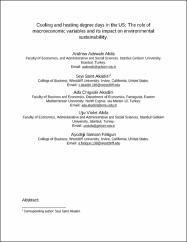| dc.contributor.author | Alola, Andrew Adewale | |
| dc.contributor.author | Saint Akadiri, Seyi | |
| dc.contributor.author | Akadiri, Ada Chigozie | |
| dc.contributor.author | Alola, Uju Violet | |
| dc.contributor.author | Fatigun, Ayodeji Samson | |
| dc.date.accessioned | 2019-12-14T18:42:21Z | |
| dc.date.available | 2019-12-14T18:42:21Z | |
| dc.date.issued | 2019 | en_US |
| dc.identifier.issn | 0048-9697 | |
| dc.identifier.issn | 1879-1026 | |
| dc.identifier.uri | https://hdl.handle.net/11363/1540 | |
| dc.description.abstract | Beyond employing the cooling and heating degree days variables for evaluating the climatic conditions and the expected energy needs in the United States, a subtle concern is the underpinning role of the environmental sustainability amidst socio-economic activities. As such, the current study is design to examine the role of fossil fuel energy consumption, ecological footprint, and urban population on the degree days viz-a-vis the cooling and heating days in the United States over the period 1960-2015. The Autoregressive Distributed Lag bound testing model employed reveals the importance of the ecological footprint, fossil fuel energy consumption, and urban population on the cooling and heating degree days of the United States. Result posits that each of fossil fuel and the urban population plays a positive and negative role as regard the cooling degree days and the heating degree days respectively, especially in the long run. Importantly, the empirical results support the argument that the increase in the consumption of the fossil fuel sources of energies are responsible to cause more cooling degree days, thus resulting to longer and hotter periods in the United States but vice versa for the heating degree days. Similarly, the investigation outcome draws from the argument that the increase in the urban population is a potential cause of high environmental temperature, thus responsible for lengthy heat periods (cooling degree days) and resulting in more energy needs and technologies for cooling. As expected, the reverse is the case for the heating degree days, especially in the long-run. As a policy standpoint, policymakers are to further adopt improved and effective guideline for housing and building constructions that are weather specifics. In formulating policy vehicle for each of the seasonal dynamics, the economic benefits of each of the climatic measurements should be considered especially for both the short- and long-run environmental sustainability. (c) 2019 Elsevier B.V. All rights reserved. | en_US |
| dc.language.iso | eng | en_US |
| dc.publisher | ELSEVIER, RADARWEG 29, 1043 NX AMSTERDAM, NETHERLANDS | en_US |
| dc.relation.isversionof | 10.1016/j.scitotenv.2019.133832 | en_US |
| dc.rights | info:eu-repo/semantics/openAccess | en_US |
| dc.rights | Attribution-NonCommercial-NoDerivs 3.0 United States | * |
| dc.rights.uri | http://creativecommons.org/licenses/by-nc-nd/3.0/us/ | * |
| dc.subject | Sustainable energy | en_US |
| dc.subject | Ecological footprint | en_US |
| dc.subject | Urban population | en_US |
| dc.subject | Heat energy | en_US |
| dc.subject | Time series | en_US |
| dc.subject | ENERGY-CONSUMPTION | en_US |
| dc.subject | TIME-SERIES | en_US |
| dc.subject | CLIMATE | en_US |
| dc.subject | TEMPERATURE | en_US |
| dc.subject | ELECTRICITY | en_US |
| dc.subject | EMISSIONS | en_US |
| dc.subject | TRILEMMA | en_US |
| dc.subject | TRENDS | en_US |
| dc.subject | POLICY | en_US |
| dc.subject | TRADE | en_US |
| dc.title | Cooling and heating degree days in the US: The role of macroeconomic variables and its impact on environmental sustainability | en_US |
| dc.type | article | en_US |
| dc.relation.ispartof | SCIENCE OF THE TOTAL ENVIRONMENT | en_US |
| dc.department | İktisadi İdari ve Sosyal Bilimler Fakültesi | en_US |
| dc.identifier.volume | 695 | en_US |
| dc.relation.publicationcategory | Makale - Uluslararası Hakemli Dergi - Kurum Öğretim Elemanı | en_US |



















